Bees -- a challenge

Above is a female Eastern Carpenter Bee, Xylocopa virginica. It is pollinating Passiflora incarnata, commonly
known as Purple Passionflower or Maypop. This is our nation's largest bee. They have a black spot on the top of their thorax and a bald, shiny area
on the top of their abdomen. The males have a yellow face and cannot sting. Females have a black face and can.
Females can be pests when they tunnel into wood to make their nests,
especially when woodpeckers come to dig out their larvae from house siding.
|
|
There are over 3,600 native bee species in the United States, some of which are important pollinators and in decline.
Here we consider studying bees, understanding the factors that affect their numbers, and how we hope to
better manage them within the sanctuary, surrounding neighborhoods, and beyond.
Amy Janvier, an Entomology graduate student at the University of Georgia, was monitoring bees in the sanctuary with bowls and trap nests.
Tragically she died in an automobile accident in 2020.
In her honor we planted Amy's Garden in the northeast corner of the sanctuary, close to one of her trapping sites below the powerline.
This garden is beyond the gate at the end of Falling Shoals Drive and is always open to the public.
In 2024 we started to resume Amy's work on bees.
Although we have no long-term scientific data to support the following claim,
bee numbers in the sanctuary seem both surprisingly low and declining relative to what I would
expect based on my observations around Clarke County since 1984 and living at Blue Heron Drive, part of the sanctuary, since 1995.
Over the past decade my sightings of bumblebees have dropped precipitously, for example.
The apparent decline in bees is complex. We need long-term studies at multiple sites
to understand their population dynamics and the importance of possible driving forces that affect their host plant communities, reproduction, and survival.
Our working hypotheses are that the sanctuary's bees are challenged
(1) by pesticide use on some properties outside the sanctuary
and (2) because the flower communities upon which our bees depend are generally not thriving and need restoring.
There is a greater threat from pesticides to pollinators that forage widely than
to other insects that feed locally within the sanctuary, where we don't use pesticides.
In the extreme case our leafminer moth larvae are relatively safe.
They each develop on a single leaf. Other than pesticide drift into the sanctuary, they are free from exposure.
In contrast European Honey Bees, Apis mellifera, can forage miles away from their hives. Bumblebees can go several kilometers.
Other bees with smaller ranges may still travel beyond the sanctuary's safety
and collect deadly pollen and nectar from treated flowers beyond our borders.
Of particular concern are neonicotinoid pesticides, now the the most widespread class of insecticides in the United States.
Some nurseries systemically treat ornamentals and other plants sold to homeowners with them.
Neonicotinoids can last for years in treated plants.
Thus, we suspect that some ornamentals in the neighborhoods around the sanctuary are likely dangerous to pollinators.
Some bees may collect pollen from them that will kill their larvae. A start to solving this this problem
is for gardeners to refuse to buy treated plants. Before purchasing any plant, please check if it was grown organically
or treated with chemicals that could threaten the bees in your area. Beware that even some native plants are not safe.
For the past four years we have attempted to restore healthy, season-long native wildflower communities in the sanctuary.
Deer have thwarted our efforts, despite ten hunters trying to control them. Deer have eaten much of what we have planted or sowed.
In 2024 we resorted to building fenced plots and starting an experiment with Walt Carson
to compare plant and bee communities in areas that we do or do not exclude deer.
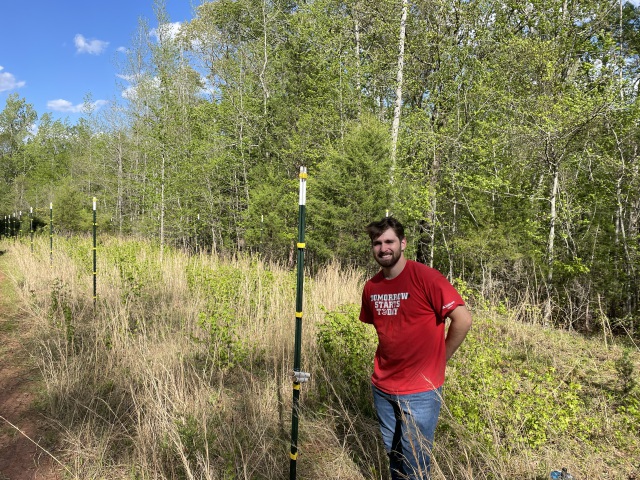
In April, 2024, we built a fence to exclude deer around this 162 x 18ft plot at the southern end of Amy's Garden.
When we established her garden in late summer 2020, we cleared this area of trees and scattered it with seeds
from seed heads that we collected in the sanctuary. It was browsed by deer since then and now contains Sweetgum saplings,
which we intend to pull, grasses, and many 2 - 4 inch wildflower rosettes flush to the ground that hopefully will flower this season.
Volunteer-in-chief Tyler Lewis is at the southwest corner of this plot. Note the set of white bee tubes on the corner t-post to his right.
We put bee tubes on the corner posts of each fenced plot, of which we now have built five. By monitoring such traps over the coming years,
we will learn if we can increase the number of trap nesting bees by excluding deer.
|
Nest -- our program to study cavity nesting bees, their parasitic wasps, and mites
|
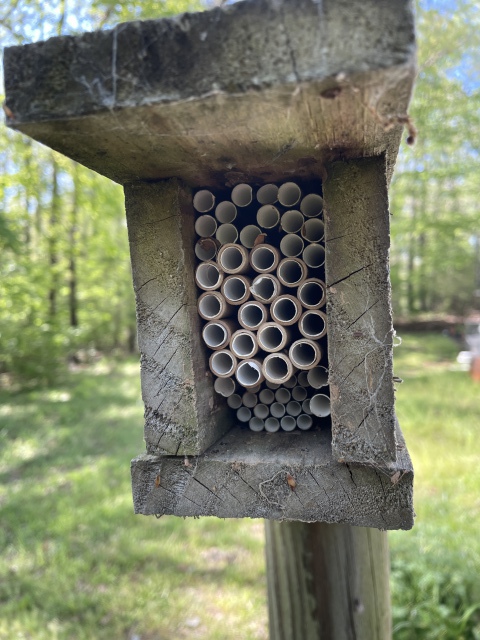
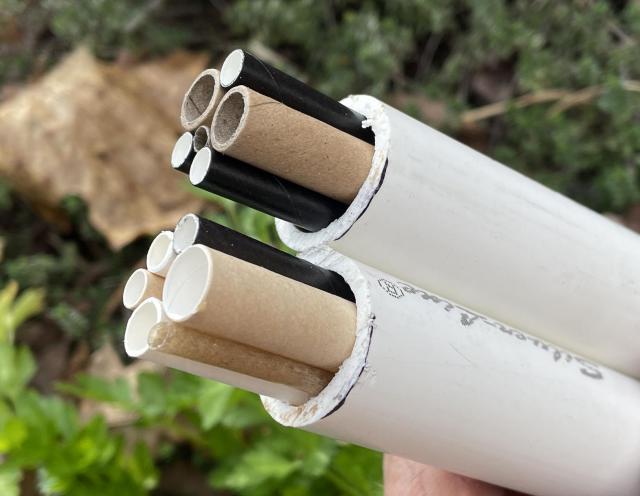
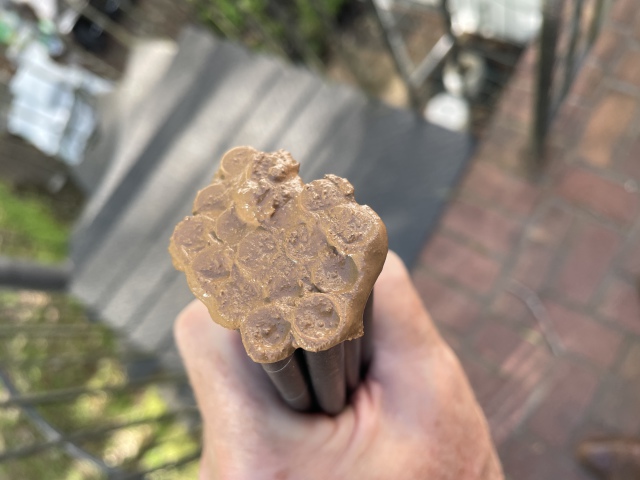
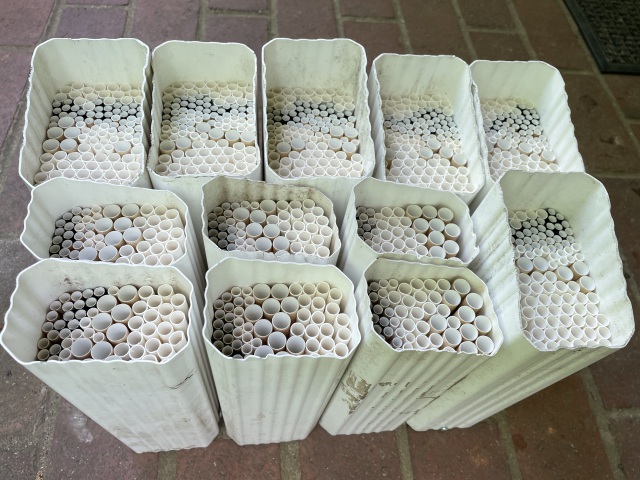
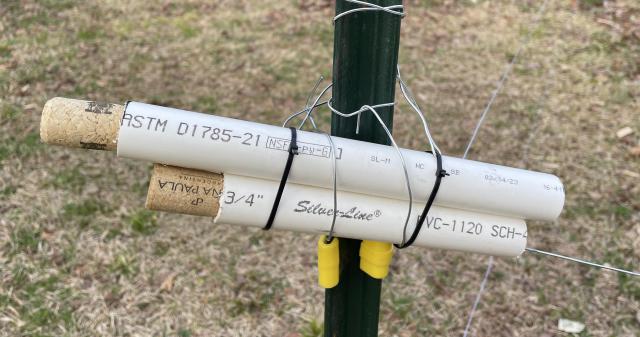
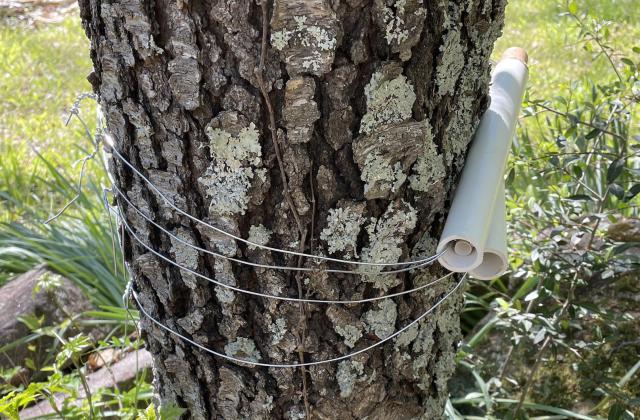
|
Our goal is to determine where bee communities are healthy, where they have been largely wiped out, and through cross-site
and cross-year comparisons, why.
Approximately 5% of North American bee species rear their offsping in naturally occurring cavities,
such as dead plant stems and used galleries of wood-boring beetles.
These cavity nesters include Mason Bees in the genus Osmia.
The genera Ashmeadiella, Chelostoma, Heriades, Hoplitis, Hylaeus, Megachile, and Protosmia
include other trap nesting species.
In 2024 we started to test inexpensive, non-lethal ways to sample cavity nesting bees and their associated species.
This effort is in partnership with bee biologists John Ascher, David Biddinger, Sam Droege and Rob Jean.
Besides giving us advice, these experts are building identification guides and checklists for cavity nesting
bees that are specific to US states and Canadian providences. Thus, ultimately high-school students
and the public at large will have online resources to help identify bees that they rear locally.
In 2024 our prototype "bee tube" sampling devices are 3/4 inch diameter PVC pipes that hold paper straws of different diameters (from 3 to 10 mm),
lengths (5 to 7.75 inches), and colors.
We plug one end of each straw, typically with creek mud, sometimes a plastic plug.
We push the straws' muddy ends into a PVC pipe and then seal it at the back with a wine cork.
Depending on straw length, the PVC pipes are between 6 to 9 inches long.
At their open end the straws are recessed a half-inch into the pipe for some protection against rain.
We lash the finished "bee tubes" to posts and trees with fence wire, ideally placing them 2 - 3 feet from the ground, with the open end facing southeast
and at a slight angle downward to drain rain. If we put them on trees, we place them on the north side of the tree so that they are shaded.
We are putting them out in the spring and will collect them at the end of nesting season, after which we will check the straws for bees,
ideally releasing as many of the ones that we rear as possible.
We are testing the tubes at sites with different land uses, levels of flower resources, and pesticide use.
In 2024 we have placed them in open habitats across the sanctuary and
with the help of Laura Ney, Clarke County's Cooperative Extension agent,
at sites run by volunteers around the the county.
In partnership with Shelby Schulman with beekeepers of alveole.buzz, friends, and colleagues,
we will test the tubes in CA, GA, IL, IN, KY, MA, MD, NC, OH, PA and TX.
Notably, we are testing them in parallel with successful cavity traps run by David Biddinger in apple orchards full of Osmia in Pennsylvania.
No promises, folks, these things may not attract a single nesting bee. Please help us try and have hope.
The top image on the left is one of Amy's bee houses that we refurbished with new straws.
The second two images are tubes under construction, the first showing a variety of different straws and the second, some straws with mud seals.
The next is of larger 66- and 126-straw "drain pipe" traps following David Biddinger's design, which we'll run on the sanctuary in parallel with our smaller tubes.
The bottom two images are of tubes lashed to a t-post and to a cherry tree.
|
SHIELD -- understanding larger geographic patterns, interactions, and driving forces
In 2018 three dozen scientists, including EO Wilson, Kama Bawa, and leaders
from the Smithsonian Institution, National Ecological Observation Network, and the Organization of Biological Field Stations,
attended a workshop at Harvard University sponsored by the Polistes Foundation.
They conceptualized SHIELD,
the goal of which is to run standard monitoring protocols across
a continental-wide network of study sites to understand environmental interactions, changes, and threats.
When implemented, SHIELD will measure the importance of variables that drive biodiversity and environmental processes
by analyzing natural experiments in which measured variables differ over time and across sites
(ref Hargrove and Pickering,1992). To measure the importance of drought on insect communities, for example,
SHIELD would statistically compare insects sampled across wet versus dry sites and wet versus dry years.
We do not know what factors are causing the sanctuary's moths, beetles, and caddisflies to prosper
and how these differ from unfavorable ones in places where insects are suffering.
We plan to find out using SHIELD.
By 2025 we will have built and tested methods to study birds and bees
across the United States and Canada. These methods include Listen for birds
and Nest for bees.
We have nearly finished testing Listen.
It is simple enough that Jojo, our 6-year-old grandson,
enjoys using it and has learnt most of our birds in the process.
Currently Discover Life has 5 virtual servers and 25 terabytes of data in the campus cloud of Sam Houston State University, Texas.
We seek funds to expand this capacity to support up to 50,000 sites reporting high-quality bird and bee data.
There are 3,143 counties in the United States and 298 in Canada. We aim to recruit up to 200 teachers and citizen scientists
per county, thus creating SHIELD's network with the geographic structure and statistical power to answer questions both within and between regions,
and across a spectrum of land uses from urban, to rural, to wildlands.
One of the first tasks for SHIELD will be to address the unintended consequences
for wildlife of spraying naled and other insecticides to control mosquitoes. Naled is a powerful organophosphate insecticide.
It is banned by the EU but is registered for use in the US. According to the EPA it is sprayed over 16 million acres
each year, largely in southern states. For example, after Hurricane Harvey in 2017 the US Air Force, using low-flying C-130's,
and two contractors sprayed 6.8 million acres of east Texas with 101,253 liters of Dibrom® containing naled and 48,735 liters of Duet™
containing 1% prallethrin and 5% sumithrin, two other insecticides. In some years possibly as much as a quarter Florida is sprayed one or more times
for mosquitoes. Other than the impact of naled on uncovered commercial honeybee hives,
little work has been done to document its impact on non-target arthropods, birds, and other wildlife.
Frighteningly, our anecdotal observations in Miami-Dade, Broward, Alachua and Duval counties
suggest that swathes of Florida may now becoming largely devoid of bees, moths and insectivorous songbirds.
Depending on what we find with SHIELD, it may be time to change national policy on the widespread use of broad-spectrum insecticides.
Stopping vectored disease transmission by mosquitoes is critical for public health, but there are better ways
to control mosquitoes without devastating wildlife.
Invasive Species -- Control Without Chemicals
Besides needing legal protection from development and resource extraction, conservation areas must be cleared of aggressive invasive species
or they will be overrun by them. Since 2019 we have found and are tackling 29 species of invasive plants in the sanctuary,
with Chinese Privet, Autumn Olive, and Japanese Stiltgrass being the most widespread and menacing.
We also have four invasive arthropods of major concern, the Emerald Ash Borer, Asian Lady Beetle, Joro Spider, and Imported Fire Ant.
Fearing any unintended consequences to non-target organisms, we do not use any herbicides, insecticides, or other pesticides in the sanctuary.
We rarely even treat our dog, Echo, with drugs that prevent ticks, fleas, and heartworm, because it is known that manure of treated
cattle has wiped out dung beetles in some areas of the US. Instead we are studying our invasives, finding their weaknesses, and testing
different ways to control them.
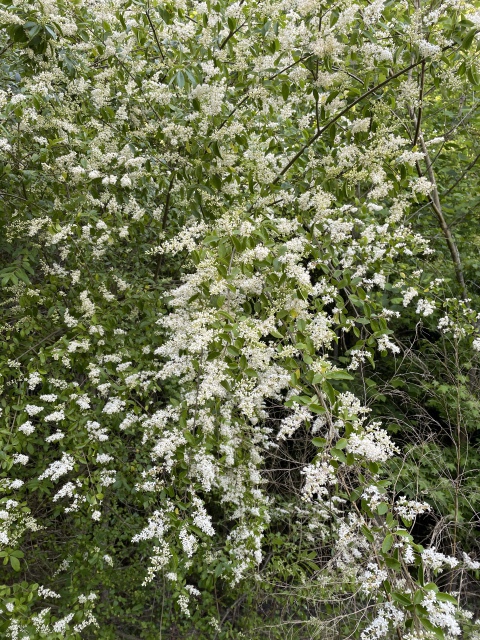
|
|
Chinese Privet was brought to this continent in 1852 as an ornamental. By the 1930's it had escaped from cultivation in the Southeast.
As the above photograph taken in the sanctuary on 9 May, 2022 shows, privet's floral display can be impressive.
However, it is a major invasive nuisance in many areas, particularly in wetter ones.
On our floodplain it had formed a dense midstory that shaded our native plants.
Our largest privet exceeds a foot in diameter and 50 ft tall. It is a specimen tree which we have kept alive as an educational eye-opener.
Except for the Two-spotted Spider Mite that we have found attacking it, our privet lacks arthropod herbivores.
Thus, it contributes virtually nothing to the foodchain of feeding our birds and other insectivores.
In the image it is noteworthy that there are no bees or other flying insects,
possibly reflecting our perceived sorry state of the sanctuary's pollinators -- a problem we plan to study and must address.
|
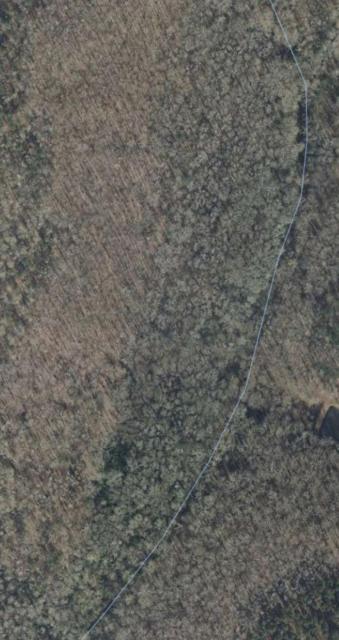
|
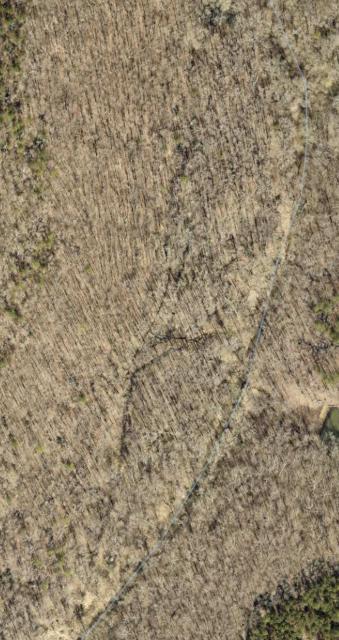
|
| 2013 | 2021
|
|
These aerial photographs are from qPublic.net and were taken when our deciduous trees had dropped their leaves.
In each image Shoal Creek is marked with a blue line. The floodplain is to the left of the creek.
Rattlesnake Slope, a deciduous oak-hickory stand, is to the left of the floodplain.
On the upper, far left are some Loblolly Pines in our upland forest. There is also a dense stand of pines in the lower right.
The dammed end of Blue Heron Pond is in the middle on the right edge.
The green in the 2013 image shows that much of the floodplain was then covered by dense privet trees.
The 2021 photograph shows that we cleared them.
|
We have learnt much about controlling privet without herbicides.
Our methods are successful and should work to remove privet elsewhere.
They may be generally applicable to other woody invasives.
We are now testing them on Autumn Olive.
Our methods to control privet in a nutshell:
- We stop reproduction completely in one area before moving on to another.
- We chainsaw larger trees that cannot be uprooted at beaver-height, cutting any basal shoots or ones on the stump at the same time.
There is no need to paint the stumps with herbicide. Most resprout in 6 months but then die within 3 years.
- We learnt the hard way NOT to cut privet at ground level. Doing so increased to over 60% the survival of 2,500 large individuals
that we cut at beaver-height, flagged, let resprout, and then cut again at ground level.
In contrast, with some exceptions, expecially in the wetter parts of the floodplain, virtually all of the ones that we cut just once at beaver-height died.
- Ideally we cut invasives after they flower and before their fruit is ripe, thus draining energy stored in their roots.
- We uproot any that we can pull up in preference to chainsawing them.
- We manually pull smaller plants when the ground is moist. We make repeat passes in subsequent years to get the ones
that we missed. Fortunately, Chinese Privet does not have a seed bank. Its seeds germinate in the first growing season after dispersal.
- We use a propane torch that throws out half a million BTU to target and burn resprouting stumps that we cannot pull. We do so again if necessary.
After controlling privet, we move on to Japanese Stiltgrass, an invasive annual which started to increase after it was no longer shaded by midstory privet.
In August and September 2023 we weedwhacked acres of this grass before it could produce seeds. By so stopping reproduction each year, we will eventually drain its
3-7 year seed bank and control it too.
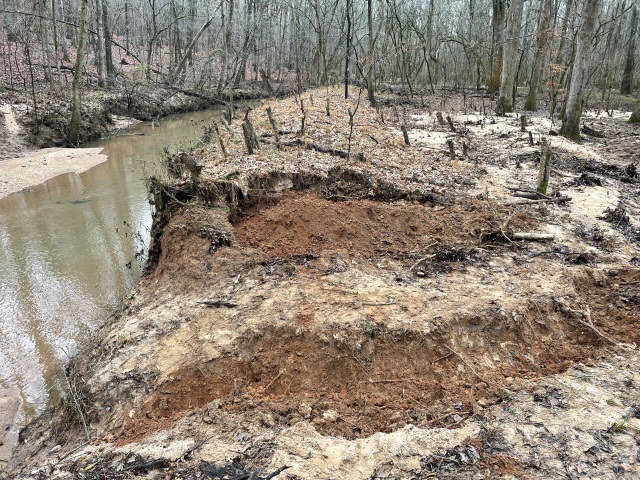
|
|
The above image faces downstream with Shoal Creek on the left, the man-made levy in the center, and the floodplain on the right.
It was taken on 17 January, 2023, two weeks after the floodwater had receeded, depositing the white sand below this breach in the levy.
In the foreground the red dirt is where we dug into the levy, lowering the threshold for future floods to
reengage the creek with its floodplain. The dead stumps on levy and floodplain in the background are privet that we cut approximately 30 months before.
This is the height at which beaver cut privet, causing most to die. We learnt from our beavers.
|
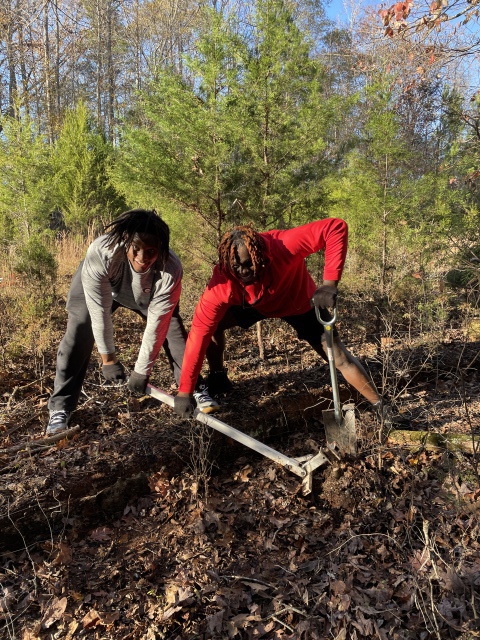
|
|
Many students, community volunteers, and employees help us to manage the sanctuary.
Here two of Georgia's national champion football team, Jared Wilson and Amarius Mimms, demonstrate how to
wrench out an Autumn Olive root by applying their 640 pounds to the equation. They won. Go Dawgs!
|
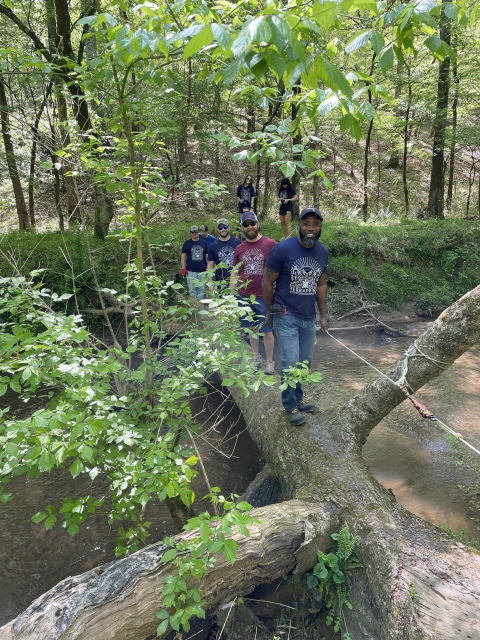
|
|
Volunteers from Terrapin Brewery cross the creek to pull privet on 22 April, 2022.
|
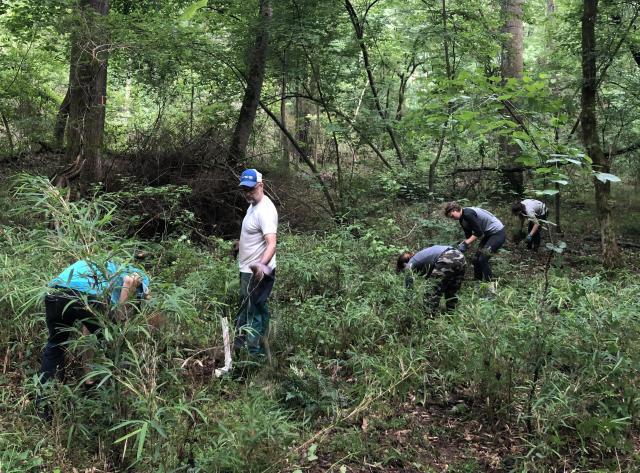
|
|
Someone actually has to weed the privet. Thank you Ian, Brian, Keira, Jackie, and Tiffany.
|
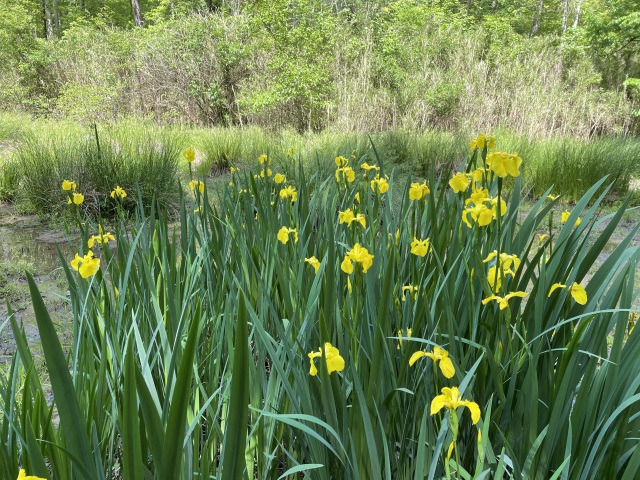
|
Like privet, Yellow-flag Iris can be both a horticultural beauty and possible invasive nightmare.
Unbeknownst of their danger to aquatic areas, I planted some by Blue Heron Pond in 1996.
I was thrilled when they established and flowered. A decade later I was horrified when they had spread around the
pond. Their dense stands, such as the last remaining one featured above, crowd out native vegetation
with the exception of the cane and woody species.
In 2011 we made a futile attempt with machetes to control their spread.
In 2019 we started again in earnest with this strategy to eradicate them:
-
Every year we cut all flowers and seed pods around the pond to stop recruitment,
-
then chop off leaves to weaken large plants,
-
and finally, a month or so later, dig and pull up any resprouting tubers and small plants.
When we started this endeavor Albert Meier,
the plant ecologist who founded the Green River Preserve in western Kentucky, a director of the Polistes Foundation, and a dear friend,
warned that this was an unwise, impossible task that would consume the rest of my life and ultimately end in failure.
Assuming that I live another couple of years, I will prove Albert wrong. This year we are removing the last of our iris stands.
Over the next two years we will root out any missed stragglers and so completely eradicate the pond's population.
Our success rests in part on the dedication and hard work of our helpers, such as the Rev. Alan Jenkins featured below, having fun doing
some of God's dirty work, in this case, pulling irises from the mud. If this is not for you, the solution is very simple. Plant
native species local to your area. Avoid my mistake. NEVER PLANT EXOTIC SPECIES THAT COULD BECOME INVASIVE.
|
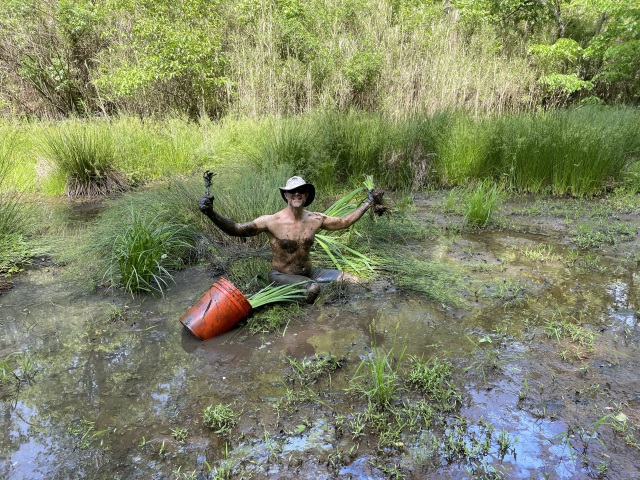
|
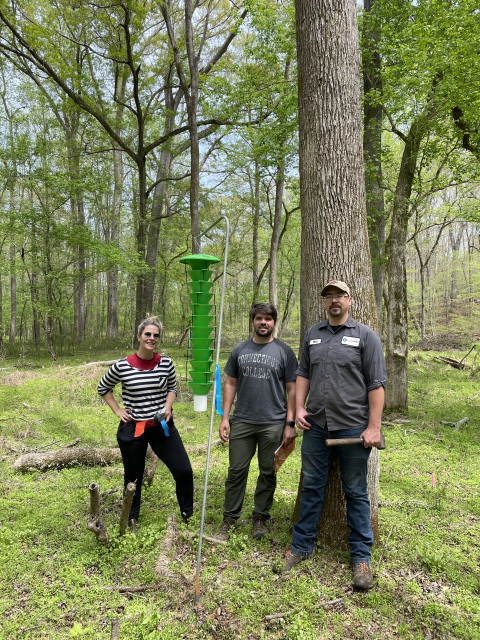
|
|
Brittany Barnes, Mitchell Green, and Whit Bolado from the University of Georgia's Warnell School of Forestry on 11 April, 2022.
As part of Mitchell's Master's degree, they are trying to establish two species of parasitoid wasps
as biological control agents of Emerald Ash Borer. Their release sites are on our floodplain and at four sites in other north Georgia counties.
Our floodplain has about 100 large Green Ash trees with an incipient attack of these invasive Asian beetles.
With help from our 7 species of woodpeckers, we hope that the wasps will save
at least some of these trees and our White Ash above the floodplain. Note two more dead privet stumps by Brittany's knee.
|
Other management issues -- powerline easement, planting natives, deer
The sanctuary has 18 acres of open areas that we are restoring with local native wildflowers and grasses,
making them more friendly for bees and other pollinators. In doing so there are considerable challenges that we must overcome,
some of which are external to the sanctuary and outside of our direct control.
For example, we must work with Georgia Power, which oversees the management of the power easement along our northern border.
We must also engage our neighbors and teach them environmentally sound practices that
are safer for themselves and for the bees, birds, and other wildlife that we share.
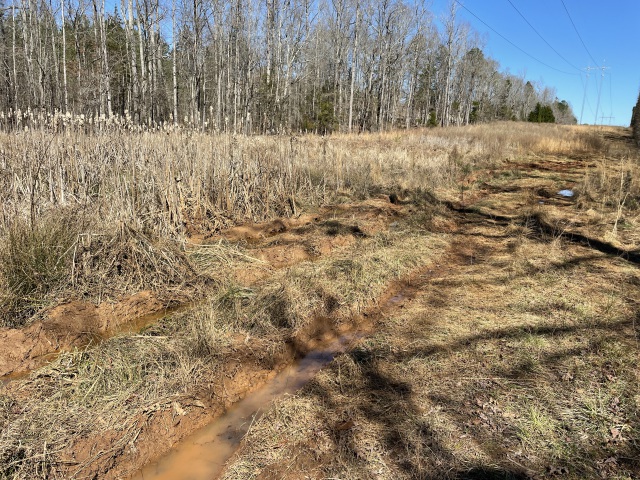
|
|
The above photograph taken on 28 February, 2022 faces north. It shows part of the powerline that follows our 1.1 mile border
between the sanctuary on the right and Falling Shoal subdivision on the left.
The seeding Cattails on the left are in a wetland that is fed from the subdivision. It drains under the rutted road through
a colvert into our West-East Creek, which flows into Shoal Creek. The road is part of the 0.8 mile pink trail mapped above.
The powerline easement is an opportunity for Georgia Power, our Falling Shoals neighbors, and us
to restore open habitat and build a wildlife corridor. We plan to sow native seeds and control trees under the powerline with a winter mowing regime
that encourages the reproduction of desirable species. We will neither spray herbicides to kill small trees
nor mow any part of the wetland, as Georgia Power's contractors have done in the past three years. It is easy to control
trees with chainsaws and by uprooting them. There is absolutely no need to kill them with dangerous herbicides.
|
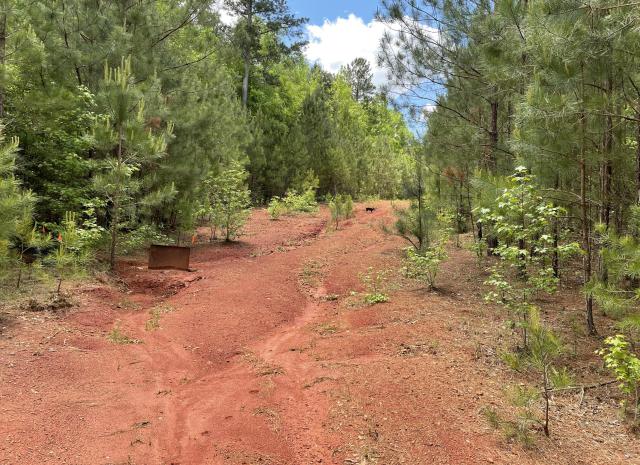
|
|
The subdivision developers cleared 8 acres of forest along 1.4 miles of roads that they
graded but failed to pave. The above picture taken on 6 May, 2021 is a section of our East Road.
It shows how little plant succession had taken place over the 13 years since the building of the subdivision's
infrastructure ended. Except for some colonizing Loblolly Pines and Sweetgum trees along the road's edges,
there are few plants on the hard-packed, eroding red clay. As a first step in its restoration,
we put a metal plate and built a small dam to divert some of the road's run off into a storm
drain that is near the orange flags on the left.
|
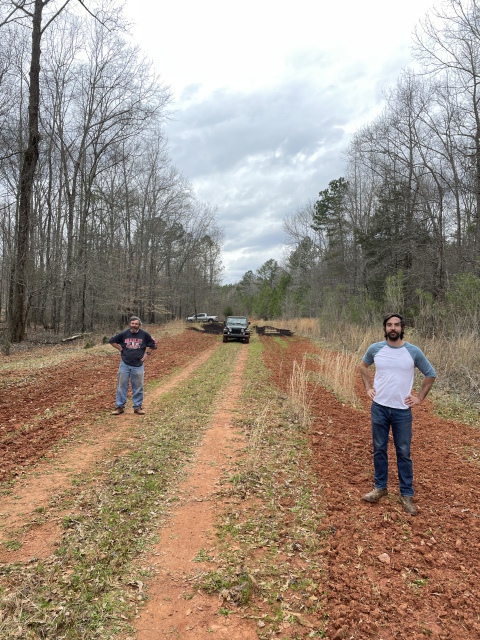
|
|
Above are Bill and Sammy Pickering on 15 March, 2022 standing around on part of our South Road,
an area that we wish to restore into native wildflowers and grasses.
Our steps are to mow the land, till it, spread compost, till it again, roll it, sow a diverse mix of native seeds,
roll it again, and then wait for nature to take its course.
In this photograph we have mowed and tilled the land and are in the process of spreading compost,
the black patch between the truck and Jeep in the distance.
We thank the Athens-Clarke County Solid Waste Depatment
for its donation of 100 cu yd of compost to the sanctuary.
|
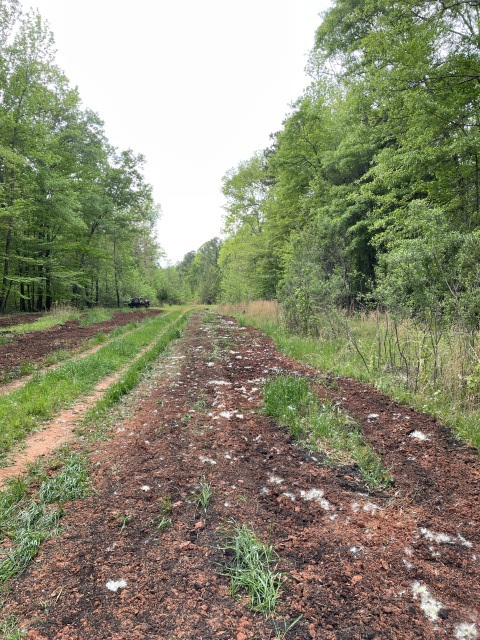
|
|
Above shows the same area on the South Road on 21 April, 2022 after we had finished
spreading compost, tilling it in, and sowing seeds. The white spots are milkweed seeds
that we added to the seed mix. Unfortunately, presumably because of dry weather in May and June,
virtually none of what we sowed germinated. We'll try again.
|
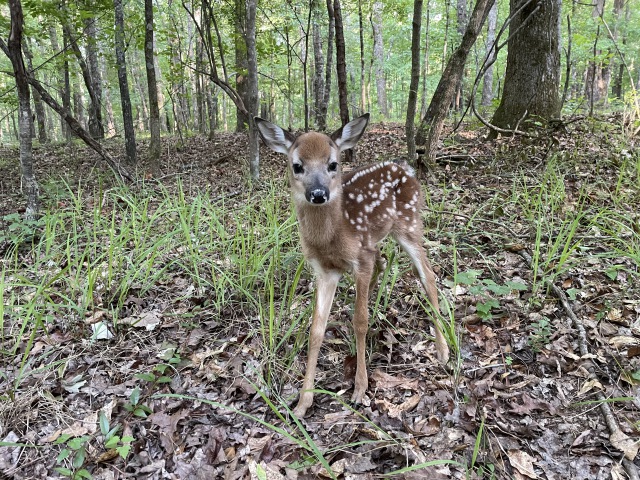
|
|
Fawns such as this one are super cute and we would be pleased to have some deer in the sanctuary.
However, our deer population, lacking its larger natural enemies, is way too high. They are
considerably detrimental to many species of desirable plants, some of which are disappearing from the sanctuary.
|
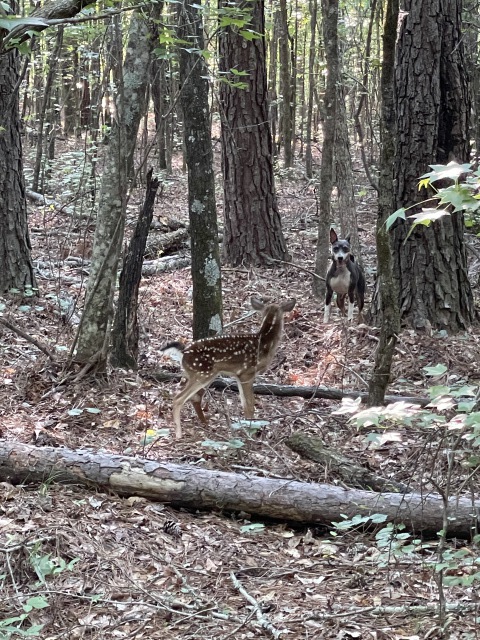
|
|
Besides Echo shown above, we have about a dozen hunters each year trying to control our deer population. Go Dawgs!
|
Safety
Because of hunting and various other dangers, please do not go into the sanctuary without permission.
Amy's Garden is always open to you. It is after the East Gate at the end of Falling Shoals Trail.
If you have permission to enter the sanctuary, ALWAYS WEAR ORANGE during deer season,
which is from early September through the end of January. Do not risk getting shot by
one of our hunters or a poacher.
Outside of hunting season, from February though August, we will soon open for public hiking and discovery the Pink Trail
and the Last Child in the Woods area that it surrounds. We need to put up some trail signs before we do.
Outreach -- learning, volunteering, enjoying
People and knowledge are the critical resources needed to study and conserve nature. Fortunately, we have a wonderful community
of supportive neighbors and are near a major research university that provides much of the expertise that we need.
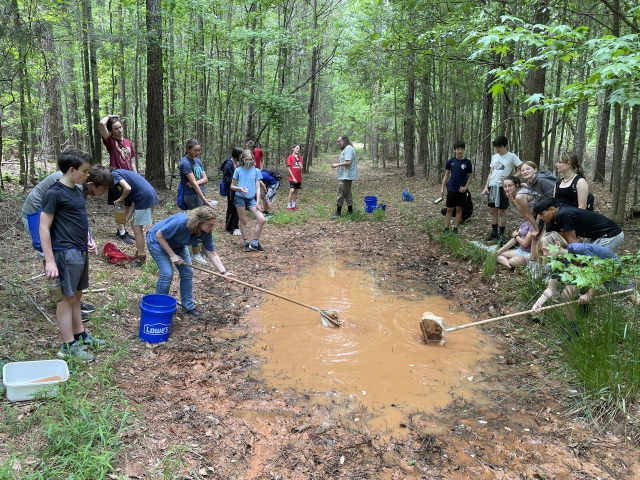
|
|
We welcome both individuals and groups who wish to come to the sanctuary and participate.
Audrey Hughes is our Outreach Coordinator. Here she is, with the net on the left, teaching a middle school class
the art of mucking about to sample amphibians. Please contact her if you are a teacher or group leader and wish to arrange
for us to host a field trip for your class or organization.
|
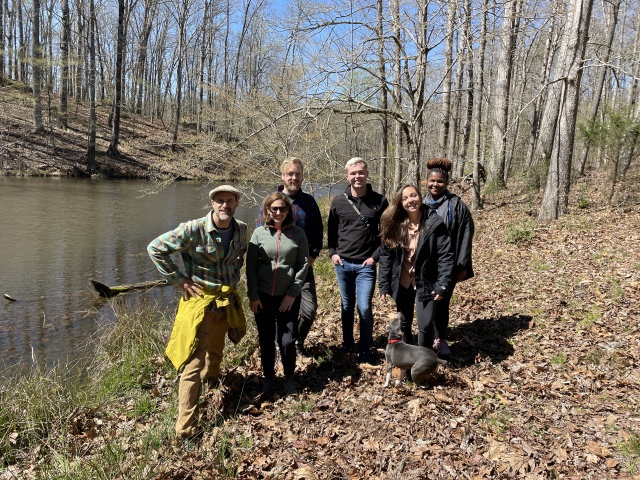
|
|
On 13 March, 2023, the Rev. Alan Jenkins and Georgia Interfaith Power and Light team visited the sanctuary
(from left to right: Alan and GIPL's Joanna, Codi, Jay, dog Echo seeking attention, Hannah, and Tsharre).
We are partnering with GIPL to help religious organizations better steward the Creation.
We will meet with them and 15 religious leaders from Athens on 19 April, 2023, to start our journey together.
|
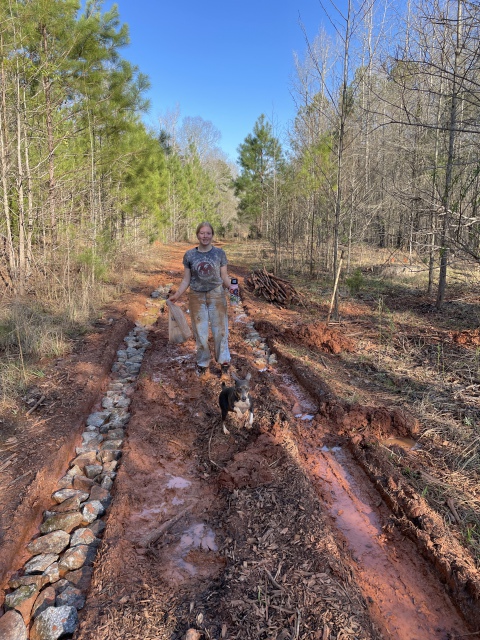
|
|
Coriander McGreevy is a senior at Cedar Shoals High School. She has worked with us for two years and is our Youth Leader.
Here she is, not dressed for the prom, enjoying the muddy task of laying rocks in ruts. Echo abounds. Coriander
has entered over 100 bird species into Listen that she recorded at her house with Merlin.
|
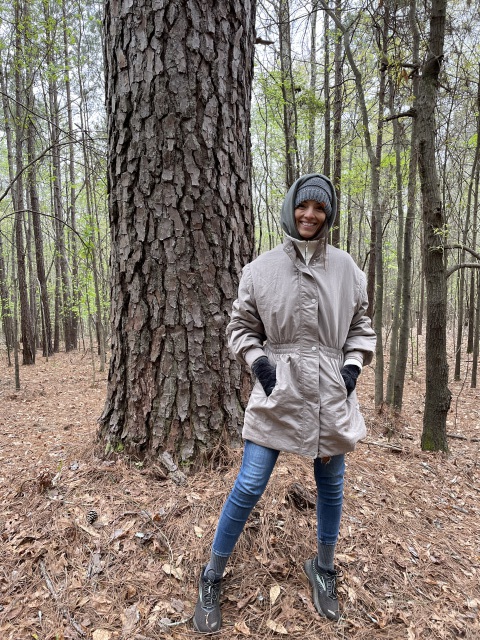
|
|
This is the largest Loblolly Pine on the property, probably dating from around the Civil War and
a parent of some of the seed trees in our upland forest. Vanessa Ponce de Leon is also featured.
She is advising Discover Life on how to build a leadership program called People with a Purpose.
It is modelled after Miss World's Beauty with a Purpose. We intend for it to provide free technology
to help organizations successfully manage and evaluate volunteers working on projects that benefit society
and our environmental wellbeing.
|
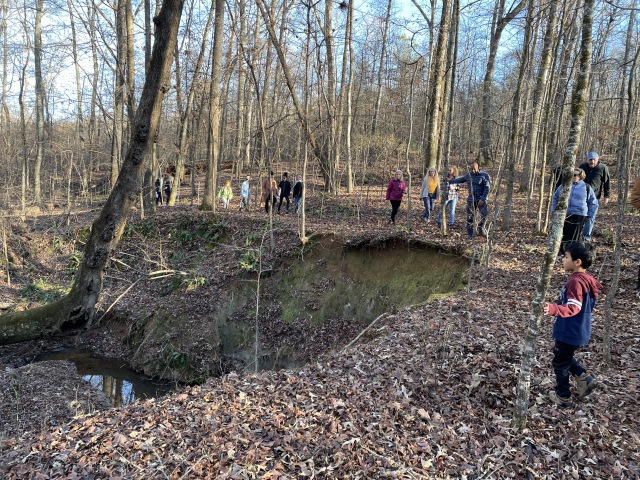
|
|
Periodically we host Sundays in the Sanctuary, guided hikes for the community.
Here is one along our West-East Creek on 12 December, 2021. It is on part of the 0.8 mile trail
mapped above and has the worst of our erosion. Soil washed down the hill and built up the creek bank.
The creek bed is at the same level it was before farming. Most sediment that falls into it eventually
is washed away and ends up on floodplains or in the Atlantic.
|
The Future
Shoal Creek Sanctuary is privately owned, legally protected through its conservation easement
overseen by the Oconee River Land Trust, and supported financially through donations made to the Polistes Foundation.
The foundation's mission is to assemble and share knowledge in order to improve education, health,
agriculture, economic development, and conservation throughout the world.
It is starting a capital campaign, Discovering for Life, which if successful will support
Discover Life and Shoal Creek Sanctuary so that both can
expand their programs and continue them into the future.
For Discover Life it is setting up an endowment at Sam Houston
State University to make sure that there is sufficient support
to keep the website running indefinitely. For the sanctuary it plans to
double the amount of land under conservation, build a field
station that will facilitate more intensive study the sanctuary's natural history
and ecological processes, and most importantly, protect our long-term
studies from the whims of the availability of soft money to support them.
In this regard, we need to understand ecological changes and processes over centuries,
not just decades. Governments fail, universities and religions last longer, natural processes remain.
It's time to build a sustainable future.
On at a continental scale we support the concept of Conserving and Restoring America the Beautiful,
a federal initiative for a community-led campaign to put 30% of the nation into conservation by 2030
-- a goal known as 30x30. Lessons from the sanctuary may help understand the obstacles that 30x30
must overcome to be a success. We have been struggling for nearly a year with
county planning and tax program constraints to add 6.8 acres that Elizabeth and John Barton have
generously offered to donate to the sanctuary, for instance. We need to change local, state, and federal
regulations rapidly for 30x30 to have any chance of success (by 2050?).
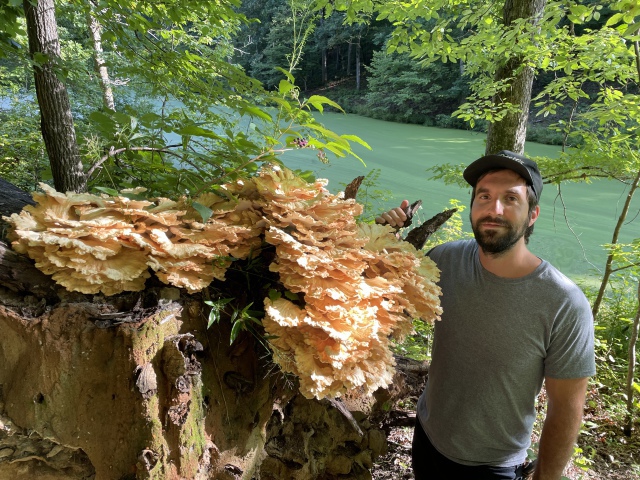
|
|
Meet Sammy Pickering, standing beside a giant Chicken-of-the-Woods, prize breakfast for a month or two.
This edible fungus is growing on a large dead oak log, over two feet in diameter.
Because we have many rotting logs, which we do not salvage, the sanctaury is well endowed
with a diversity of fungi, beetles, and other species that depend on rotting wood. As a delightful sign of
our healthy, mature forest, over 200 uncollected Hercules and Giant Stag Beetles,
both species of which are detritrivores as larvae, have come to our lights.
Regarding Sammy, he graduated with a degree in horticulture from the University of Georgia
and now works as a part-time land steward with the Oconee River Land Trust.
He helps manage the sanctuary, most notably by growing native species on it.
He will manage the sanctuary when his parents move on.
|
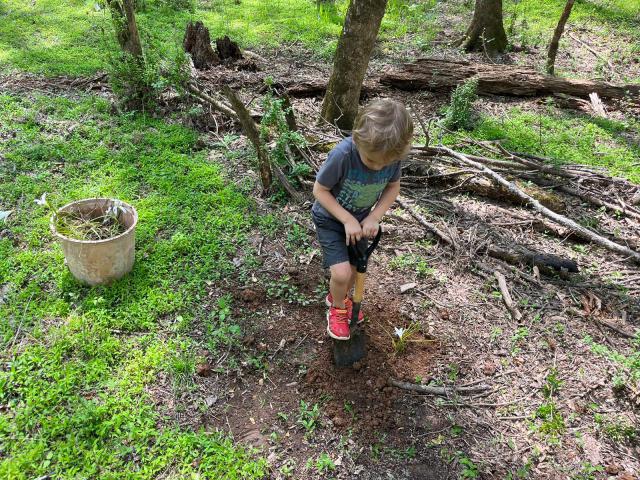
|
|
And then there's Jojo, here planting an Atamasco Lily under the tutelage of Sammy.
We hope that he's interested in continuing in the job when Sammy moves on.
|
Contacts:
• John Pickering -- pick@discoverlife.org -- 706-254-7446
• Kevin Weick, Polistes Foundation -- weickkd@gmail.com -- 617-484-6428
• Audrey Hughes, Outreach -- awh1922@gmail.com -- 706-612-6897
Updated: 19 April, 2024